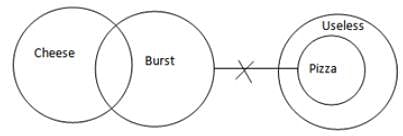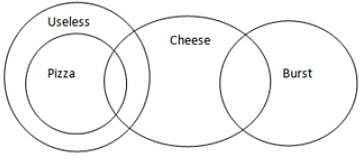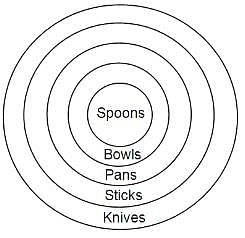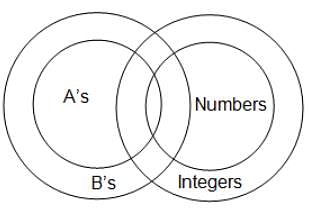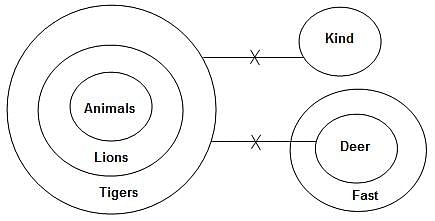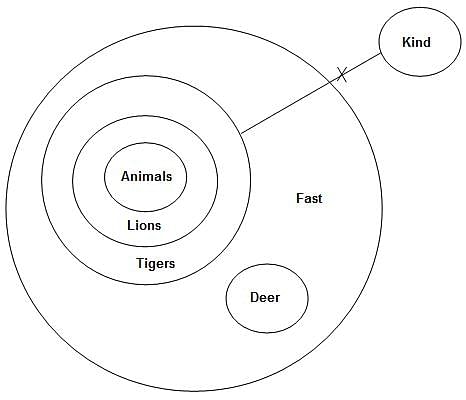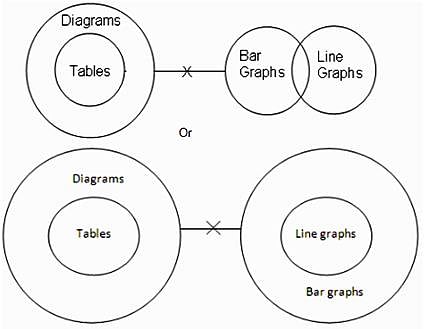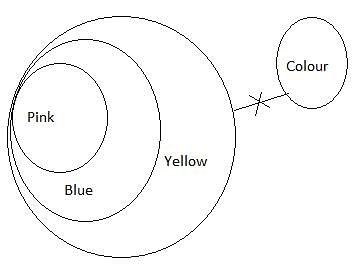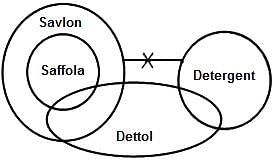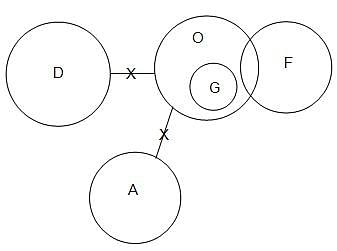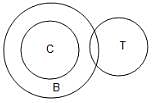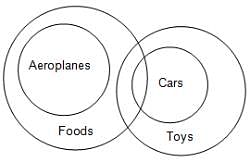Test Level 1: Syllogism - 2 (September 5) - CAT MCQ
10 Questions MCQ Test Daily Test for CAT Preparation - Test Level 1: Syllogism - 2 (September 5)
Directions: In the question below, three statements are given, followed by three conclusions numbered I, II and III. You have to take the given statements to be true even if they seem to be at variance with commonly known facts. Read all the conclusions and then decide which of them logically follows from the given statements, disregarding commonly known facts.
Statements:
Some cheese is burst.
No burst is pizza.
All pizzas are useless.
Conclusions:
I. No cheese is pizza.
II. Some burst is useless.
III. Some pizzas are cheese.
Some cheese is burst.
No burst is pizza.
All pizzas are useless.
Conclusions:
I. No cheese is pizza.
II. Some burst is useless.
III. Some pizzas are cheese.
Directions: The question below consists of four statements followed by three conclusions numbered I, II and III. You have to take the given statements to be true even if they seem to be at variance from commonly known facts. Read all the statements and then decide which of the given conclusions logically follow(s) from the given statements, disregarding commonly known facts.
Statements:
All spoons are bowls.
All bowls are pans.
All pans are sticks.
All sticks are knives.
Conclusions:
I. Some knives are pans.
II. Some sticks are bowls.
III. Some pans are spoons.
All spoons are bowls.
All bowls are pans.
All pans are sticks.
All sticks are knives.
Conclusions:
I. Some knives are pans.
II. Some sticks are bowls.
III. Some pans are spoons.
Directions: This question consists of three statements followed by four conclusions marked I, II, III and IV. Consider the statements to be true, even if they seem to be at variance from commonly known facts, and decide which of the given conclusions logically follow(s) from the statements, disregarding commonly known facts. Mark your answer accordingly.
Statements:
(a) All A's are B's.
(b) Some A's are numbers.
(c) All numbers are integers.
Conclusions:
I. Some B's are numbers.
II. All B's are numbers.
III. All B's are A's.
IV. Some integers are A's.
(a) All A's are B's.
(b) Some A's are numbers.
(c) All numbers are integers.
Conclusions:
I. Some B's are numbers.
II. All B's are numbers.
III. All B's are A's.
IV. Some integers are A's.
Directions: Decide which of the given conclusions logically follow(s) from the given statements and choose the correct option.
Statements:
All animals are lions.
All lions are tigers.
No tiger is deer.
All deer are fast.
No tiger is kind.
Conclusions:
(I) All animals are not deer.
(II) Some animals are not fast.
(III) Some kind are lions is a possibility.
(IV) Some animals are not kind.
Directions: In the question below are given three statements followed by three conclusions numbered I, II and III. You have to take the given statements to be true even if they seem to be at variance from commonly known facts. Read all the conclusions and then decide which of the given conclusions logically follow(s) from the given statements disregarding commonly known facts.
Statements:
All tables are diagrams.
No diagram is a bar graph.
Some bar graphs are line graphs.
Conclusions:
I. Some tables are not bar graphs.
II. Some line graphs are not bar graphs.
III. All tables are bar graphs.
Directions: In this question, three statements are given followed by three conclusions numbered I, II and III. You have to take the given statements to be true even if they seem to be at variance from commonly known facts. Read all the statements and then decide which of the given conclusions logically follow(s) from the given statements, disregarding commonly known facts.
Statements:
All pinks are blues.
All blues are yellow.
No yellow is colour.
Conclusions:
I. All pinks are yellow.
II. Some blues being colours is a possibility.
III. Some colours being pinks is a possibility.
Directions: In the question below are given three statements followed by conclusions numbered I, II and III. You have to take the given statements to be true even if they seem to be at variance with the commonly known facts. Read all the statements and then decide which of the given conclusions logically follow(s) from the given statements, disregarding the commonly known facts.
Statements:
Some saffola are dettol.
All saffola are savlon.
No savlon is detergent.
Conclusions:
I. No detergent can be saffola.
II. Some savlon are dettol.
III. No dettol is detergent.
Directions: Read the statements carefully and decide which of the given conclusions logically follow(s) from the given statements.
Statements:
No detergents are oils.
Only oils are greases.
Some films are oils.
No oils are actors.
Conclusions:
(I) Some greases are films.
(II) No film is grease.
Directions: This question consists of two statements followed by two conclusions marked I and II. Consider the statements to be true, even if they seem to be at variance with commonly known facts, and decide which of the given conclusions logically follow(s) from the statements, disregarding commonly known facts. Mark your answer accordingly.
Statements:
(a) All cows are bees.
(b) Some trees are bees.
Conclusions:
I. All trees are cows.
II. Some cows are trees.
Directions: In the question below, three statements are given followed by three/four conclusions. You have to take the given statements to be true even if they seem to be at variance from commonly known facts. Read all the conclusions and then decide which of the given conclusions logically follow(s) from the given statements, disregarding commonly known facts.
Statements:
All aeroplanes are foods.
Some foods are cars.
All cars are toys.
Conclusions:
I. All aeroplanes are cars.
II. All toys are aeroplanes.
III. Some toys are foods.
|
152 docs|327 tests
|


